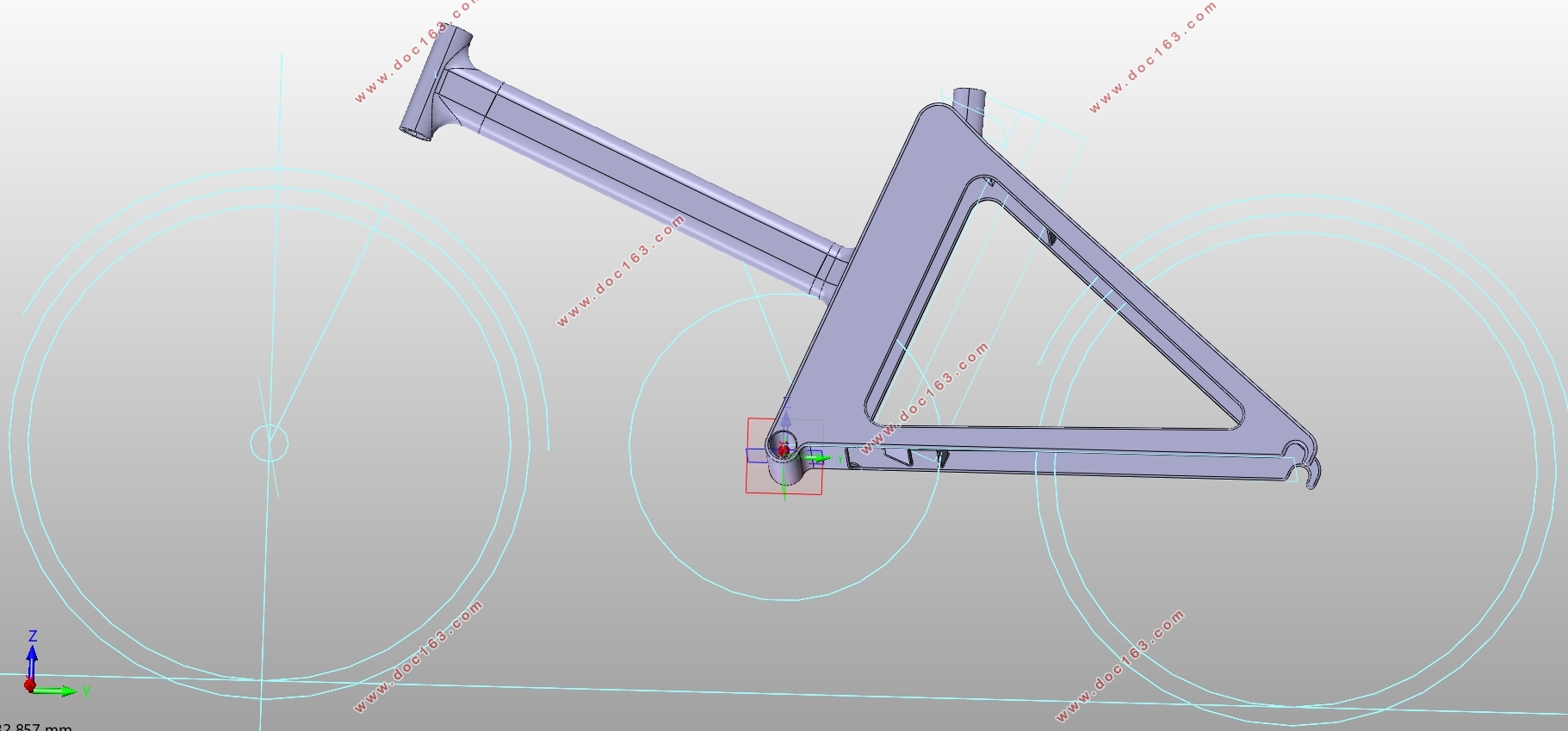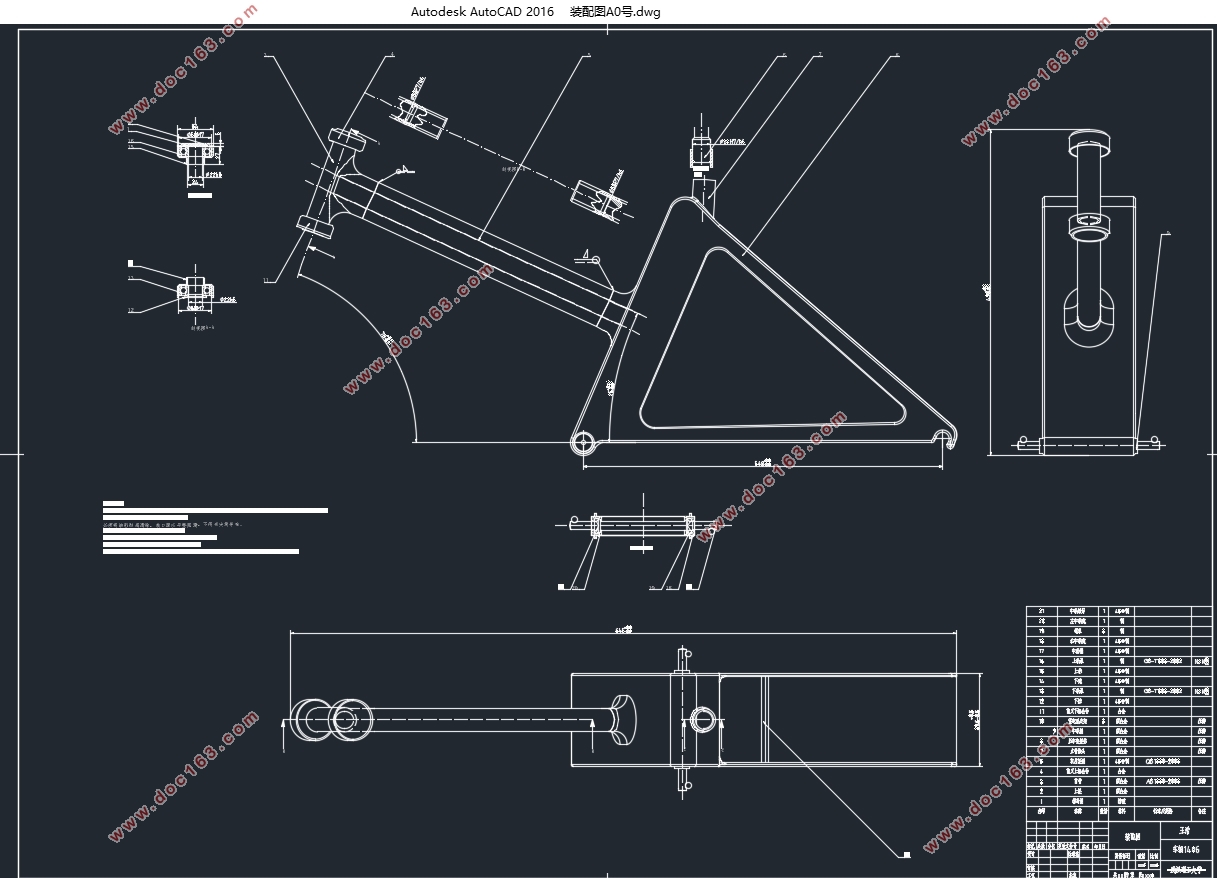电动自行车的车架设计与优化(含CAD零件图装配图,CATIA三维图)

电动自行车的车架设计与优化(含CAD零件图装配图,CATIA三维图)(任务书,开题报告,文献摘要,外文翻译,论文说明书19000字,CAD图6张,CATIA三维图)
摘要
根据电动自行车的服役环境、使用要求以及面相对对象,选择车架的材料,设计车架的几何参数模型,分析各参数对车架性能的影响。
针对镁合金的材料特性,设计车架加工工艺。研究车架在匀速工况、起步工况和制动工况下的受力情况。通过简化模型,对车架危险截面进行强度校核和刚度校核。之后根据计算数据家里车技三维模型。
用ANSYS软件对车架三维模型进行材料选择、网格划分以及边界约束和加载等操作,为有限元分析做准备。利用有限元分析,分别对电动自行车车架在匀速工况、起步工况和制动工况三种工况下的受力状况、应力分布、应变分布以及变形量大小进行研究,并根据分析结果对电动自行车车架结构进行优化。最终得到满足使用要求的车架。
关键词:电动自行车;车架设计;CAE分析
Abstract
According to the service environment of the electric bicycle, the requirements of use and the relative object, select the material of the frame and design the geometric parameter model of the frame, then analysis the influence of the parameters on the performance of the frame is analyzed. [资料来源:http://Doc163.com]
Design the processing technology of frame based on the material characteristics of magnesium alloys. The stress of frame is studied under uniform speed condition, starting condition and braking condition. Through the simplified model, the strength of the dangerous section of the frame is checked and the stiffness is checked. Then, the 3D model of the car technology is calculated according to the data.
The ANSYS software is used for material selection, mesh generation, boundary constraint and loading operation of the 3D model of the frame, so as to prepare for the finite element analysis. The finite element analysis is used to study the force condition, stress distribution, strain distribution and deformation size of the electric bicycle frame under three conditions of uniform speed, starting and braking, and the structure of the electric bicycle frame is optimized according to the analysis results. Finally the frame meeting the requirements of the use is finished.
Key words: electric bicycle;frame design;the CAE analysis technique
[资料来源:http://www.doc163.com]
电动自行车参数
表2.1 电动车相关参数
参数 参数
车轮直径(mm) 510 最高时速(km/h) 25
极限载重(kg) 140
面向对象:年轻上班族,多用于上下班骑行,行驶于城市道路中距离骑行,男性





[资料来源:Doc163.com]

目录
第一章 绪论 1
1.1课题研究的背景、目的和意义 1
1.2国内外研究现状 1
1.3课题研究内容和预期目标 2
第二章 电动自行车车架设计 4
2.1 电动自行车参数 4
2.2车架基本结构与选材 4
2.2.1产品定位分析 4
2.2.2车架设计原则 4
2.2.3车架类型与材料的确定 6
2.3整车动力设计 8
2.3.1电动机参数设计 8
2.3.2蓄电池位置选择 9
2.4车架结构设计 10
2.4.1车架几何尺寸设计 10
2.4.1.1曲柄长度OJ 10 [资料来源:https://www.doc163.com]
2.4.1.2中接头下垂度N 10
2.4.1.3传动中心距OB 12
2.4.1.4立管倾斜角β 12
2.4.1.5立管高度 OF 12
2.4.1.6前心距OA 13
2.4.1.7前管倾斜角θ和前叉翘度H 13
2.4.1.8其他参数 15
2.4.2车架工艺设计 16
2.4.3车架强度计算 16
第三章 电动自行车车架三维模型与有限元模型的建立 20
3.1 车架三维建模 20
3.2车架有限元模型 20
3.2.1有限元模型导入 20
3.2.2网格划分 20
3.2.3材料特性 21
3.3本章小结 21
第四章 电动自行车车架有限元分析及优化设计 21
4.1边界条件设置和加载处理 21
4.2匀速工况分析 22
4.2.1边界约束与加载 22
4.2.2匀速工况分析结果 22
[资料来源:http://Doc163.com]
4.2.3结果分析 24
4.3起步工况 24
4.3.1边界约束与加载 24
4.3.2起步工况分析结果 24
4.3.3结果分析 27
4.4制动工况 27
4.4.1边界约束与加载 27
4.4.2制动工况分析结果 28
4.4.3结果分析 30
4. 5电动自行车结构优化 31
4.5.1结构优化 31
4.5.2优化效果 31
4.5.2.1匀速工况 31
4.5.2.2起步工况 33
4.5.2.3制动工况 36
4.8本章小结 38
第五章 结论 38
5.1全文总结 38
5.2展望 39
致谢 40
参考文献 41 [资料来源:https://www.doc163.com]
上一篇:空调管道清洁机器人设计(含CAD零件图装配图,SolidWorks三维图)
下一篇:CK6125数控车床主传动系统设计(含CAD零件图装配图)
